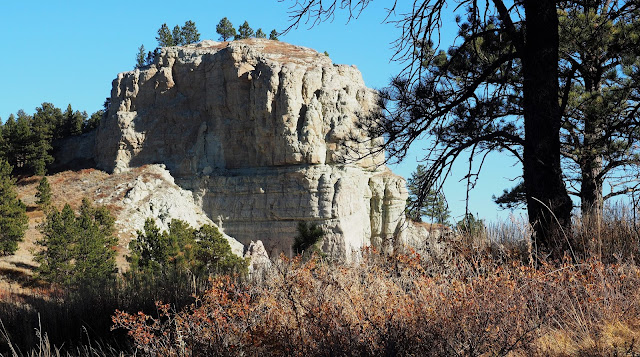That the hide painting is mislabeled is no one’s fault, really. Somewhere along the line of ownership it was likely a slip of the tongue that got typed up and inserted in the description–“the Battle,” the note says, “of Twin Buttes” [emphasis mine].
Honestly, there should be a “Battle of Twin Buttes.” What a great title. John Wayne scans the horizon from his saddle, a hundred Lakota braves, bedecked for war, awaiting a chilling scream from Crazy Horse.
There never was such a battle, not in the American West or in a Hollywood film can. There’s only one “Battle of Twin Buttes,” and that’s a wonderful hide painting on the wall at the Sioux County Museum, Orange City, Iowa. Stop in and see for yourself.
But the fight that painting describes is not generic. Up in the right hand corner, four cavalry are pouring lead down on a village. The Lakota would not have chosen to fight anywhere close to their women and children, so the drawing details a cavalry attack on a camp. Probably a surprise attack too, given that picket line–and regrettably, the women and children drawn in among the victims. Those rifles appear to be taking aim at an dying brave in a flowing headdress who stands in front of a woman and a cradle-board baby already bloodied.
Here’s my guess. This wonderful piece of Native American folk art tells the story of the Battle of Slim Buttes, a surprise attack on a camp that was not at war, a fight that took place way out in the northwest corner of South Dakota, a bloody engagement between the U.S. Cavalry and bands of Lakota the army called “hostiles,” most of whom wanted only to go on living the way they always had.
Under the command of General George C. Crooke and an army just a few months before defeated at Little Big Horn, Captain Anson Mills, with 150 troopers, ran into the village pictured on the hide, and, contrary to Crook’s express orders, decided to attack. Mills and his men were thirty miles from the General’s half-wasted army, a haggard bunch who’d been slogging through the mud for more than a hundred miles with nothing to eat but their horses.
Crook had advised no fighting because he was close to fighting mutiny himself. But Mills determined to bring down 40-some lodges of two Minniconjou leaders, American Horse and Red Horse. No white man was in the mood for peace post-Custer.
Some who escaped the attack, including American Horse, took to adjoining hills and found refuge in a gully. Twenty troopers volunteered to go down and get them. And they did, “cursing and yelling,” or so the story goes.
“The yelling of Indians, discharge of guns, cursing of soldiers, crying of children, barking of dogs, the dead crowded in the bottom of the gory, slimy ditch, and the shrieks of the wounded,” one who was there remembered, “presented the most agonizing scene that clings in my memory of Sioux warfare.”
Eventually, American Horse surrendered, stood straight and tall, then walked out of that gully holding his intestines in his hands and died soon after.
When the firing ceased, Captain Mills’ famished troops filled their larder and themselves with meat, the first time some of them had eaten anything in days. When Crook’s troops arrived, he almost lost control of them–all 2000–very quickly.
All that buffalo meat was bounty from band’s summer hunt. That’s why American Horse and his people were there, but because they were “off reservation,” they were considered “hostile,” even though the whole band was simply on their way home.
The hide drawing in the museum is, in truth, the Battle of Slim Buttes, some of it anyway.
Seriously, the place is gorgeous today, just as it must have been in September of 1876. Bright, alabaster buttes rise like winged ships, tall above a prairie where “the deer and the antelope play”–and the pronghorn. Wildflowers down below carpet the grasses, and ponderosa pine stand tall as tributes high atop the buttes.
Be warned. Slim Buttes are way, way off the beaten path. No one just stops by on their way to Denver or Yellowstone. Foot traffic is unheard of. You got to want to go to Slim Buttes. Like so much of American history, what happened on that land in 1876 is hardly a footnote amid all that beauty. What’s more, if you believe that museum hide painting, you’ll go on a wild goose chase and never get there at all.
Maybe that’s a shame. Then again, maybe not. After all, if you know the story and you can get there on your own sometime, you can see the place all by your lonesome. If you do, who knows what you might still hear from somewhere down at the foot of those magnificent buttes? After all, who knows what they might just remember?
Who knows? Maybe we’re not the only ones surrounded by a cloud of witnesses.



